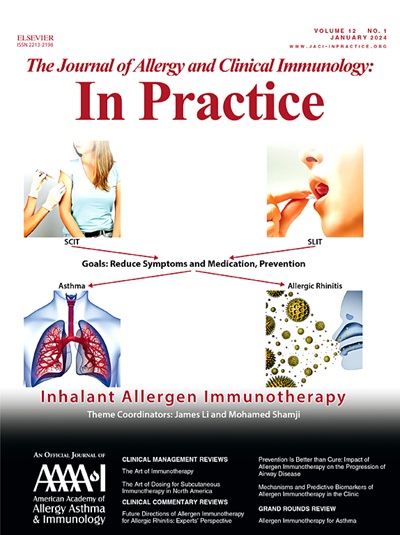显性阴性与功能获得性STAT3缺陷:流行病学、临床、免疫学和分子方面的系统综述。
IF 8.2
1区 医学
Q1 ALLERGY
Journal of Allergy and Clinical Immunology-In Practice
Pub Date : 2025-06-01
DOI:10.1016/j.jaip.2025.04.014
引用次数: 0
摘要
背景:种系信号换能器和转录激活因子3 (STAT3)突变引起两种不同的综合征,以感染性或自身免疫性表型为主。目的:本研究的目的是汇编STAT3中功能获得(GOF)和显性阴性(DN)突变的文献报道。方法:检索1990 ~ 2023年PubMed、Scopus、Web of Science 3个主要数据库。人工搜索所有全文文章和主要综述,以查找其他研究。结果:107篇文章共报道490例患者,其中DN-STAT3患者265例,GOF-STAT3突变患者225例。主要临床差异STAT3-DN和STAT3-GOF患者中观察到的感染性并发症率(98.2%比85.4%,P <措施)、肺炎(67.3%比52.1%,P = .006)、鼻窦炎(17.5%比2.1%,P <措施),耳炎(27.7%比5.2%,P <措施),脓肿(52.7%比17.7%,P <措施),皮肤表现(88.3%比58.4%,P <措施),过敏性疾病(66.4%比40.2%,P <措施),间质性肺病(0.7%比17.7%,P <措施),牙科/牙龈疾病(38.5%比11.7%,P <措施),内分泌病变(0.9% vs 16.5%, P < 0.001)。大多数患者淋巴细胞亚群计数正常,但STAT3-DN患者CD3+ T细胞较高,自然杀伤细胞较低,STAT3-GOF患者CD4+ T细胞较低。大多数STAT3-DN患者血清IgG、IgA和IgM浓度正常或偏高,且血清IgE几乎普遍升高。大多数STAT3-GOF患者IgG水平较低,但IgA、IgM和IgE水平正常。结论:STAT3-DN患者有复发性皮肤病和肺部感染、湿疹、IgE升高和嗜酸性粒细胞增多,而STAT3-GOF患者有早发性多自身免疫,经常需要免疫抑制治疗。本文章由计算机程序翻译,如有差异,请以英文原文为准。
Dominant-Negative Versus Gain-of-Function STAT3 Defects: A Systematic Review on Epidemiological, Clinical, Immunological, and Molecular Aspects
Background
Germline signal transducer and activator of transcription 3 (STAT3) mutations cause 2 distinct syndromes with predominant infectious or autoimmune phenotype.
Objective
The objective of this study is to compile literature reports on gain-of-function (GOF) and dominant-negative (DN) mutations in the STAT3.
Methods
We searched 3 main databases including PubMed, Scopus, and Web of Science from 1990 to 2023. All full-text articles and major reviews were manually searched for additional studies.
Results
A total of 490 patients were reported in 107 articles including 265 patients with DN-STAT3 and 225 patients with GOF-STAT3 mutations. Major clinical differences between STAT3-DN and STAT3-GOF patients were observed in rates of infectious complication (98.2% vs 85.4%, P < .001), pneumonia (67.3% vs 52.1%, P = .006), sinusitis (17.5% vs 2.1%, P < .001), otitis (27.7% vs 5.2%, P < .001), abscess (52.7% vs 17.7%, P < .001), dermatologic manifestation (88.3% vs 58.4%, P < .001), atopic disorders (66.4% vs 40.2%, P < .001), interstitial lung disease (0.7% vs 17.7%, P < .001), dental/gingival disorders (38.5% vs 11.7%, P < .001), and endocrinopathies (0.9% vs 16.5%, P < .001), respectively. Most patients had normal counts of lymphocyte subsets, with the exceptions of higher CD3+ T cells and lower natural killer cells in STAT3-DN patients, and lower CD4+ T cells in STAT3-GOF patients. Most STAT3-DN patients had either normal or high serum concentrations of IgG, IgA, and IgM with almost universal raised serum IgE. Most STAT3-GOF patients had a low level of IgG, but normal levels of IgA, IgM, and IgE.
Conclusions
Patients with STAT3-DN had recurrent dermatological and pulmonary infections, eczema, elevated IgE, and eosinophilia, whereas patients with STAT3-GOF had early-onset polyautoimmunity and frequently require immunosuppressive therapy.
求助全文
通过发布文献求助,成功后即可免费获取论文全文。
去求助
来源期刊

Journal of Allergy and Clinical Immunology-In Practice
ALLERGYIMMUNOLOGY-IMMUNOLOGY
CiteScore
11.10
自引率
9.60%
发文量
683
审稿时长
50 days
期刊介绍:
JACI: In Practice is an official publication of the American Academy of Allergy, Asthma & Immunology (AAAAI). It is a companion title to The Journal of Allergy and Clinical Immunology, and it aims to provide timely clinical papers, case reports, and management recommendations to clinical allergists and other physicians dealing with allergic and immunologic diseases in their practice. The mission of JACI: In Practice is to offer valid and impactful information that supports evidence-based clinical decisions in the diagnosis and management of asthma, allergies, immunologic conditions, and related diseases.
This journal publishes articles on various conditions treated by allergist-immunologists, including food allergy, respiratory disorders (such as asthma, rhinitis, nasal polyps, sinusitis, cough, ABPA, and hypersensitivity pneumonitis), drug allergy, insect sting allergy, anaphylaxis, dermatologic disorders (such as atopic dermatitis, contact dermatitis, urticaria, angioedema, and HAE), immunodeficiency, autoinflammatory syndromes, eosinophilic disorders, and mast cell disorders.
The focus of the journal is on providing cutting-edge clinical information that practitioners can use in their everyday practice or to acquire new knowledge and skills for the benefit of their patients. However, mechanistic or translational studies without immediate or near future clinical relevance, as well as animal studies, are not within the scope of the journal.
 求助内容:
求助内容: 应助结果提醒方式:
应助结果提醒方式:


